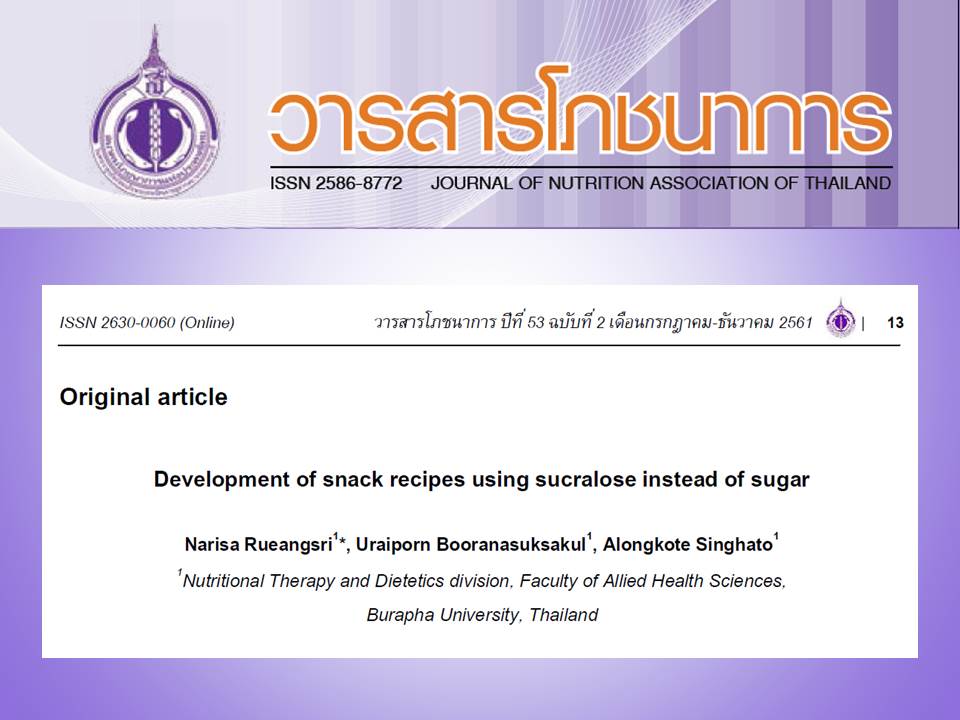Development of Snack Recipes Using Sucralose Instead of Sugar
Keywords:
Sucralose, Sugar, Artificial sweetener, SnackAbstract
Non-communicable diseases are one of the most deleterious health conditions commonly found in communities caused from long-term high amount of sugar intake. This study aimed to develop the satisfied snacks recipes using the sucralose as sweetener. Forty of participants who met the inclusion and exclusion criteria were recruited to conduct the sensory evaluation at the Faculty of Allied Health Sciences, Burapha University, Bang Saen campus, to determine their satisfaction on appearance, color, texture, flavor, taste, and overall satisfaction toward the developed snacks using the 5 level-hedonic scale. The most5 selected snacks(mixed fruits custard, aclair, pancake, strawberry pudding, and pineapple pie) were developed into sugar formula and sucralose formula. In general, results revealed there were no significant differences in all aspects of the 5 developed snacks, except for pancake which the average score on texture of sucralose formula was significantly higher than sugar formula (p<0.05) and strawberry pudding which the average score on color of sugar formula was significantly higher than sucralose formula (p<0.05). In addition, the average overall satisfaction scores indicated that participants were satisfied with all developed snacks using sucralose as sweetener. In conclusion, the developed snacks using sucralose as sweetener were satisfied and acceptable from participants.
References
Low YL, Lee LK, Samy AL. Non-communicable diseases in the Asia-Pacific region: prevalence, risk factors and community-based prevention. Int J Occup Med Environ Health. 2015;28(1):20–6.
Macdonald IA. A review of recent evidence relating to sugars, insulin resistance and diabetes. Eur J Nutr. 2016;55(2):17–23.
Jung HH, Park JI, Jeong JS. Incidence of diabetes and its mortality according to body mass index in South Koreans aged 40–79 years. J Clin Epidemiol. 2017;9:667–78.
Msyamboza KP, Mvula CJ, Kathyola D. Prevalence and correlates of diabetes mellitus in Malawi: population-based national NCD STEPS survey. BMC Endocr Disord. 2014;14:41.
Aekplakorn W, Stolk RP, Neal B, Suriyawongpaisal P, Chongsuvivatwong V, Cheepudomwit S, et al. The prevalence and management of diabetes in Thai adults: the international collaborative study of cardiovascular disease in Asia. Diabetes Care. 2013;26(10):2758-63.
Rojjanawanicharkorn A, Luangpituksa P, Siriwedchayant S, Changcharoen T. The situation of using artificial sweetener instead of sugar in instant beverage powder. J Nurt Assoc Thailand. 2017;52(1):12-22.
Hudthagosol C, Chusak C. Sugar and diabetes. J Nurt Assoc Thailand. 2015;50(2):26-35.
Romo-Romo A, Aguilar-Salinas CA, Brito-Córdova GX, Díaz RAG, Valentín DV, Almeda-Valdes P. Effects of the non-nutritive sweeteners on glucose metabolism and appetite regulating hormones: systematic review of observational prospective studies and clinical trials. PLoS One. 2016;11(8):e0161264.
Gupta P, Gupta N, Pawar AP, Birajdar SS, Natt AS, Singh HP. Role of sugar and sugar substitutes in dental caries: a review. Int Sch Res Notices. 2013:519421.
Rocha IFO. Passion fruit juice with different sweeteners: sensory profile by descriptive analysis and acceptance. Food Sci Nutr. 2015;3(2):129–39.
DutraI MBL. Bolini HMA. Physicochemical evaluation of acerola nectar sweetened with sucrose and different sweeteners. Food Sci Technol (Campinas). 2013;33(4):150-8.
Hanko VP, Rohrer JS. Determination of sucralose in Splenda and a sugar-free beverage using high-performance anion-exchange chromatography with pulsed amperometric detection. J Agric Food Chem. 2004;52(14):4375-9.
Grotz VL, Munro IC. An overview of the safety of sucralose. Regul Toxicol Pharmacol. 2009;55(1):1-5.
Hellfritsch C, Brockhoff A, Stähler F, Meyerhof W, Hofmann T. Human psychometric and taste receptor responses to steviol glycosides. J Agric Food Chem. 2012;60(27):6782-93.
Rueangsri N, Sumrit T, Booranasuksakul U, Singhato A. Acceptance and satisfaction on the developed Thai dessert recipes using artificial sweeteners. Proceedings of the 20th World Congress on Clinical Nutrition (WCCN) 2016, Traditional Medicine, Functional Food, Nutrition, Natural Health Product and Spiritual Healing: Additional Tools for Healthcare Delivery; 2016 December 14-16; Rama Gardens Hotel, Bangkok. Bangkok: Thammasat University; 2016:29-34.
Sapphanchang W, Wa-Ubon T, Nuket P, Booranasuksakul U, Rueangsri N, Singhato A. Development of Low-Sodium Food Recipes According to TathuJaoruen Belief: Semha Element. Proceedings of the 1st National Graduate Research Conference and Creative Innovation Competition; 2017 August 17-18; The Empress Hotel,Chiangmai.Chiangmai: Mae Jo University; 2017:435-45.
Singhato A, Banjong O, Charoonruk G. Effectiveness and acceptance of the developed educational media on the application of a Thai ethnic snack, Thong Pub, with calcium fortification. J Ethn Foods. 2017;4(1):58-63.
Singh-Ackbarali D, Maharaj R. Sensory evaluation as a tool in determining acceptability of innovative products developed by undergraduate students in food science and technology at the University of Trinidad and Tobago. J Curric Teach. 2014;3(1):10-27.
Savitha YSD, Indrani IJ. Effect of replacement of sugar with sucralose and maltodextrin on rheological characteristics of wheat flour dough and quality of soft dough biscuits. J Texture Stud. 2008;39(6):605-16.
Patil S, Ravi R, Saraswathi G, Prakash M. Development of low calorie snack food based on intense sweeteners. J Food Sci Technol. 2014;51(12):4096–101.
Pimentel TC, Madrona GS, Prudencio HS. Probiotic clarified apple juice with oligofructose or sucralose as sugar substitutes: Sensory profile and acceptability. LWT-Food Sci Technol. 2015;62(1):838-46.
Berry C, Brusick D, Cohen SM, Hardisty JF, Grotz VL, Williams GM. Sucralose non-carcinogenicity: a review of the scientific and regulatory rationale. Nutr Cancer. 2016;68(8):1247–61.
Pepino MY, Tiemann CD, Patterson BW, Wice BM, Klein S. Sucralose affects glycemic and hormonal responses to an oral glucose load. Diabetes Care. 2013;36(9):2530-5.
Miller PE, Perez V. Low-calorie sweeteners and body weight and composition: a meta-analysis of randomized controlled trials and prospective cohort studies. Am J Clin Nutr. 2014;100(3):765–77.
Centre for Cultural Risk Research, Charles Sturt University, Bathurst, Australia. The heart of the meal: food preferences and habits among rural Australian couples Deborah Lupton. Sociol Health Illn. 2000;22(1):94-109.
Al-Dabbas MM, Al-Qudsi JM. Effect of partial replacement of sucrose with the artificial sweetener sucralose on the physico-chemical, sensory, microbial characteristics, and final cost. IFRJ. 2012;19(2):679-83.

Downloads
Published
How to Cite
Issue
Section
License
Upon acceptance of an article, copyright is belonging to the Nutrition Association of Thailand.


